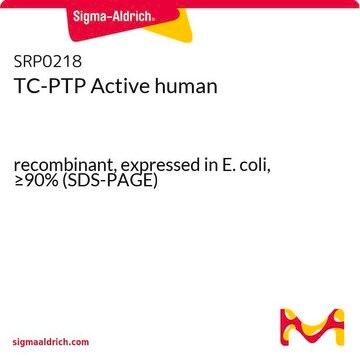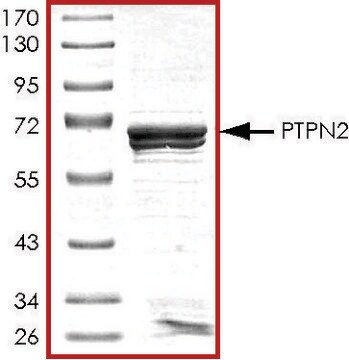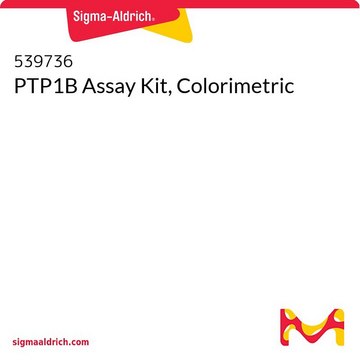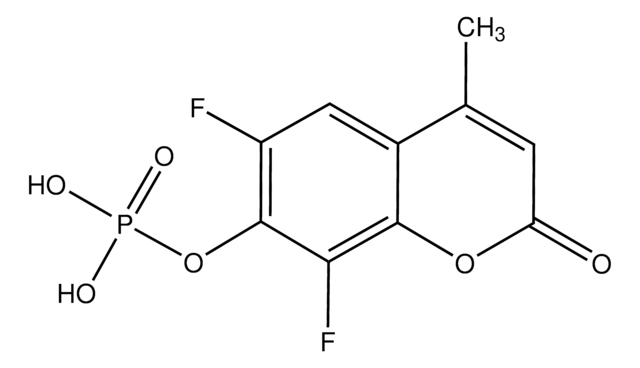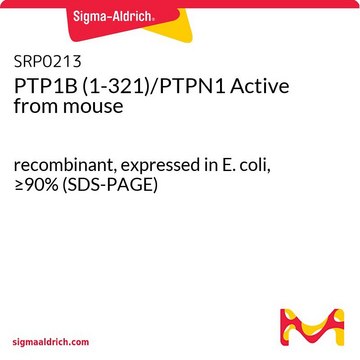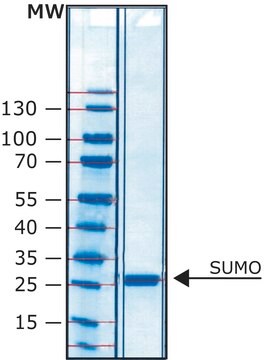SRP0212
PTP1B (1-321)/PTPN1 Active human
recombinant, expressed in E. coli, ≥90% (SDS-PAGE)
Synonym(s):
PTPN1, Protein tyrosine phosphatase, non-receptor type 1
Sign Into View Organizational & Contract Pricing
All Photos(1)
About This Item
UNSPSC Code:
12352200
NACRES:
NA.32
Recommended Products
biological source
human
recombinant
expressed in E. coli
assay
≥90% (SDS-PAGE)
form
aqueous solution
mol wt
63.3 kDa
packaging
pkg of 20 μg
storage condition
avoid repeated freeze/thaw cycles
concentration
0.84 mg/mL
NCBI accession no.
UniProt accession no.
shipped in
dry ice
storage temp.
−70°C
Gene Information
human ... PTPN1(5770)
General description
Protein tyrosine phosphatase, catalytic domain, (amino acids 1-321), (Gene bank accession no. M31724) with N-terminal GST tag, MW = 63.3 kDa, expressed in an E. coli expression system.
Protein tyrosine phosphatase, non-receptor type 1 (PTPN1), which is also known as protein-tyrosine phosphatase 1B (PTP1B), is a tyrosine phosphatase. It is localized at the cytoplasmic side of the endoplasmic reticulum. The gene encoding PTPN1 is localized on human chromosome 20q13.13.
Application
Useful for the study of enzyme kinetics, regulation, to dephosphorylate target substrates and for screening inhibitors.
Biochem/physiol Actions
Protein tyrosine phosphatase, non-receptor type 1 (PTPN1) or protein-tyrosine phosphatase 1B (PTP1B) dephosphorylates the epidermal growth factor receptor. It acts as a modulator of insulin-like growth factor receptor (IGFR) and MET-mediated signaling responses. It may be useful as a drug target in type 2 diabetes and obesity. The protein has been shown to enhance tumor progression in various cancers such as breast, colon and prostate. It acts a tumor suppressor in other cancers (lymphomas and esophageal cancers).
Unit Definition
One unit will hydrolyze 1 nmol p-nitrophenyl phosphate per minute at pH 7.4 and 30°C.
Physical form
Formulated in 25 Mm Tris-HCl, pH 8.0, 75 mM NaCl, 0.05% Tween-20, 50% glycerol, 2 mM EDTA, 1 mM DTT, and 10 mM glutathione.
Preparation Note
Thaw on ice. Upon first thaw, briefly spin tube containing enzyme to recover full content of the tube. Aliquot enzyme into single use aliquots. Store remaining undiluted enzyme in aliquots at -70°C. Note: Enzyme is very sensitive to freeze/thaw cycles.
Storage Class
10 - Combustible liquids
wgk_germany
WGK 2
flash_point_f
Not applicable
flash_point_c
Not applicable
Choose from one of the most recent versions:
Certificates of Analysis (COA)
Lot/Batch Number
Don't see the Right Version?
If you require a particular version, you can look up a specific certificate by the Lot or Batch number.
Already Own This Product?
Find documentation for the products that you have recently purchased in the Document Library.
Customers Also Viewed
Frequent amplification of PTP1B is associated with poor survival of gastric cancer patients.
Wang N
Cell Cycle, 14, 732-743 (2015)
Analysis of common PTPN1 gene variants in type 2 diabetes, obesity and associated phenotypes in the French population.
Cheyssac C
BMC Medical Genetics (2006)
Mohammad Nasir Uddin et al.
Phytochemistry, 103, 99-106 (2014-05-13)
Protein tyrosine phosphatase 1B (PTP1B) plays a key role in metabolic signaling, thereby making it an exciting drug target for type 2 diabetes and obesity. Besides, there is substantial evidence that shows its overexpression is involved in breast cancer, which
PTP1B promotes cell proliferation and metastasis through activating src and ERK1/2 in non-small cell lung cancer.
Liu H
Cancer Letters, 359, 218-225 (2015)
PTP1B-dependent regulation of receptor tyrosine kinase signaling by the actin-binding protein Mena.
Hughes SK
Molecular Biology of the Cell, 26, 3867-3878 (2015)
Our team of scientists has experience in all areas of research including Life Science, Material Science, Chemical Synthesis, Chromatography, Analytical and many others.
Contact Technical Service
